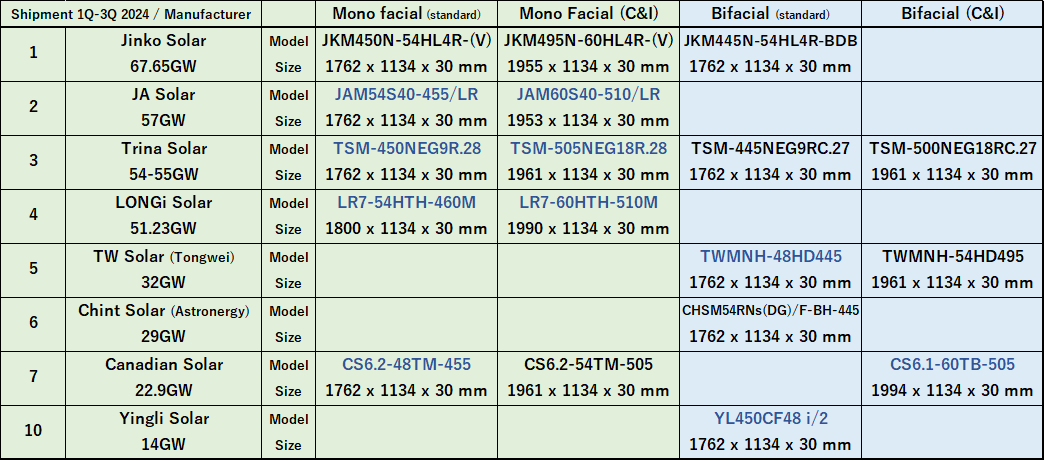PV column
Photovoltaic
2024/12/11
Chinese PV module manufacturers’ shipment ranking and module mainstream size
In 2024, PV module manufacturers are increasing the size of their cells (wafers) and increasing their output through various technological developments, resulting in a drastic change in module size and output. Competition among Chinese module manufacturers is also intensifying. In this column, we will introduce the ranking of Chinese module manufacturers’ shipments through the third quarter of 2024 and their current major module product lineup.
The following information on the Chinese module market and manufacturer trends, as well as the shipment ranking of Chinese module manufacturers for the third quarter of 2024, is based on an article and the ranking image at the top of the column of [Solarbe], a Chinese solar news website, as of late October 2024. We would like to take this opportunity to thank Solarbe for permission to reprint this article.
1. PV module shipments in the first three quarters of 2024 and projected annual shipments:

In the first three quarters, the top four companies (Jinko Solar, JA Solar, Trina Solar, and LONGi Solar) shipped a combined total of about 230 GW, accounting for more than 52% of the total, a similar result to last year. The top 10 companies in the first three quarters accounted for 81% of the total, further highlighting the dominance of the major PV module manufacturers. In particular, after the China Photovoltaic Industry Association’s price initiative was announced, most bidding prices for solar PV in China have tended to be near the lower end of the range. As a result, top ranked PV manufacturers with technological, business, and performance advantages have become more dominant in the market, gradually squeezing the survival of small and medium-sized manufacturers and objectively accelerating industry consolidation.
(reprinted/translated from Solarbe)
2. Solar modules for residential/low-voltage/C&I rooftop projects (Self-consumption/PPA):

As production processes improve, silicon wafers, the raw material for solar cells, are becoming larger in size. In addition, the output of modules has been further increased due to the rise in cell conversion efficiencies resulting from various technologies such as TOPCon. The module output used for residential and low-voltage applications was 370 watts the year before last and 410 watts last year, but now the general situation is 450 watts or more. Modules with a length of less than 2000 mm and an output of 500 watts are becoming the mainstream for rooftop application such as factories and warehouses, and their use is increasing not only in Japan but also in Australia and Europe.

3. Solar module (550 – 650 watt) for C & I application:

Until the year before last, 144 half-cut cells (166 mm cells) were distributed with an output of 450 watts, and until the first half of 2023, many manufacturers offered products with a length of 2278 mm with an output of 550 watts. There is some demand for these 2278 mm modules for older design PV plants, but due to the increase in wafer/cell size, almost all manufacturers are scheduled to discontinue production at the end of December 2025, one year later.
Almost all manufacturers now produce the unified size (2382 x 1134 x 30 mm) announced by the solar industry in July 2023, which has an output of over 600 watts and is the size with the most options for bifacial type modules.

4. Solar module (630 – 720 watt) for utility scale project:

The number of manufacturers producing extra-large size modules is slightly limited. This is the largest size module used in “Mega solar project” in Japan and in large scale ground-mount PV project around the world, and almost all manufacturers supply bifacial type. Module sizes have been consolidated into three types.
- 700 watts and above: 2384 x 1303 x 33 (35) mm
- 630-650 watts: 2465 x 1134 x 30 (35) mm
- 630-650 watts: 2172 x 1303 x 33 mm

The voltage and current values of the modules have become much higher due to the improved power output. We evaluate and propose PV system design for each project based on installation conditions and equipment specifications. Please contact us if you are interested in evaluation and comparative study for development and design of PV power plants, renovation and repowering of existing PV power plants, and expansion of PV power plants.

